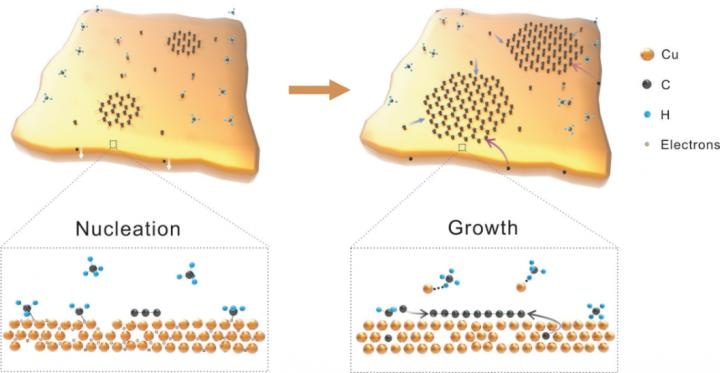Apr 3 2019
Graphene, particularly the single-crystal graphene, turns out to be a capable material for photonics and electronics in future as it possesses special properties like record thermal conductivity, great intrinsic charge carrier mobility, remarkable stiffness, and very good light transmission.
 Nucleation and growth of graphene on liquid Cu. (Image credit: Science China Press)
Nucleation and growth of graphene on liquid Cu. (Image credit: Science China Press)
But whether or not graphene can fulfill the expectations is dependent on the reliable high-quality synthesis with more efficiency. From the past few years, the fabrication technique of graphene has been successful.
Recently, researchers from Wuhan University, China, have reported the dynamic fast growth of huge single-crystal graphene on liquid Cu at a rate of 79 μm/second in Science China Materials based on the liquid metal chemical vapor deposition method.
The natural property of liquid metal qualifies it to be an ideal platform for the low-density nucleation and the fast growth of graphene. Liquid metal catalyst possesses quasi-atomically smooth surface with high diffusion rate, which can avoid the defects and grain boundaries that are inevitable on solid metal. The rich free electrons in liquid Cu accelerate the nucleation of graphene, realizing the nucleation of graphene single crystal within seconds. And in the meantime, the isotropic smooth surface greatly suppresses the nucleation density. Moreover, the fast mass transfer of carbon atoms due to the excellent fluidity of liquid Cu promotes the fast growth.
Lei Fu, Professor, Wuhan University
They investigated the growth behavior and nucleation of graphene on liquid and solid Cu in an organized way. Compared with solid Cu, there is a steady decrease in the nucleation density of graphene on liquid Cu as well as a decrease in the related activation energy. With respect to the growth rate, graphene’s growth rate on liquid Cu is nearly two orders greater than that on solid Cu.
Researchers explained the growth kinetics of the graphene growth on liquid Cu using carbon-isotope-labeling Raman spectra and discovered the distribution of carbon atoms in liquid Cu using time of flight secondary ion mass spectra. The 13C and 12C atoms were found to consistently mix in every graphene single crystal. A particular number of carbon atoms can be detected in the liquid Cu bulk than in solid Cu having very low carbon solubility.
In contrast to the surface adsorption growth process on solid Cu, the bulk segregation and the surface adsorption can facilitate the supply of precursors for the growth of graphene on liquid Cu. This is due to the large vacancies in liquid Cu, allowing the carbon atoms to first diffuse into the bulk metal before becoming separated and precipitated on the Cu surface. The dual contributions of the precursor supply, that is, the surface adsorption and the bulk segregation, can promote the rapid growth of graphene.
We think the study on the growth speed of graphene in liquid Cu system will enrich the research map of the growth of two-dimensional (2D) materials on liquid metal. More interesting and unique behaviors in the liquid surface are to be discovered. The liquid metal strategy for the rapid growth of graphene will hopefully be extended to various 2D materials and thus promote their future applications.
Lei Fu, Professor, Wuhan University
This study was supported by the National Natural Science Foundation of China (21673161) and the Sino-German Center for Research Promotion (1400).